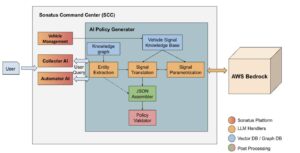The air quality model MONARCH, developed by the Barcelona Supercomputing Center-National Supercomputing Center (BSC-CNS) and executed on the MareNostrum supercomputer, has become the first model of its kind created in Spain that contributes to the Atmosphere Surveillance Service of the European Union’s Copernicus program (CAMS: Copernicus Atmosphere Monitoring Service).
This European program offers atmospheric environmental information, free and accessible, to those responsible for formulating air quality policies throughout the European territory, as well as to businesses and citizens.
The air quality model MONARCH, developed at the Barcelona Supercomputing Center and executed on the MareNostrum supercomputer, contributes to the Atmosphere Surveillance Service of the European Copernicus program.
MONARCH, acronym for Multiscale Online Non-hydrostatic Atmosphere CHemistry, is incorporated into the CAMS multi-model system along with the MINNI model developed by the Italian agency ENEA. The inclusion of both models completes a unique system in the world, composed of the eleven (formerly nine) most advanced air quality models developed in Europe, which provide daily forecasts on the concentration of atmospheric pollutants for the next four days.
These forecasts are crucial for administrations to manage the serious problem posed by air pollution to European citizens, considered the greatest environmental risk to health in Europe and one of the main causes of premature death and disease.
According to the European Environmental Agency, in 2019 alone there were 364,200 premature deaths in the European Union related to poor air quality: 307,000 due to exposure to particles smaller than 2.5 microns in diameter (PM2.5), 40,400 due to exposure to nitrogen dioxide (NO₂) and 16,800 due to exposure to tropospheric ozone.
“MONARCH is a clear demonstration of the added value of research carried out in Spain. Thanks to the continuous development of the model, today we can say that the BSC provides expanded information on air quality to policymakers and citizens throughout Europe under the aegis of the European Union’s Copernicus program, also known as Europe’s eyes on Earth,” says researcher Oriol Jorba, co-leader of the BSC Atmospheric Composition group.
The Copernicus CAMS service continuously provides quality-assured information on the main atmospheric pollutants regulated by the EU and of interest to health: ozone, nitrogen dioxide, sulfur dioxide, fine particles PM2.5 and PM10, and five types of allergenic pollen.
The system combines data obtained from environmental satellites and ground-based stations with computational models that simulate the evolution of the atmosphere to generate estimates of variables such as ozone concentration and presence of fine particles that allow for air quality forecasts for the coming days.
A computational air quality model is a mathematical representation that aggregates and synthesizes all factors that influence the conditions of the air we breathe: meteorology (wind, rain, temperature, etc.), mobility (traffic patterns, speed profiles, etc.), and the main sources of pollutant emissions (traffic, industry, natural sources, etc.). MONARCH is a state-of-the-art air quality model that is continuously developed on the BSC’s MareNostrum supercomputer, as the equations describing atmospheric processes are very complex and must be resolved through supercomputing.
“The model development began in 2008 by BSC researchers with the aim of advancing knowledge of the physicochemical processes of the atmosphere. In 2014, the system was established as the operational model of the World Meteorological Organization’s Regional Specialized Meteorological Center for Atmospheric Sand and Dust Forecast, the Barcelona Dust Regional Center, providing forecasts of dust intrusions in North Africa, the Middle East, and Europe,” Jorba adds.
In recent years, MONARCH has been improved to meet the requirements of the CAMS production service, which includes perfecting chemical processes, representation of bioaerosols, data assimilation of reactive species, workflow optimization for operational production, use of forcing conditions from the European Centre for Medium-Range Weather Forecasts (ECMWF), and periodic updates of emission flows.
Collaboration with CAMS consortium partners, together with ECMWF support, has greatly contributed to the success of the operational deployment of the MONARCH model in Copernicus.
“The inclusion of this model in CAMS European air quality forecasts is another success of the BSC Earth Sciences department. Members of the Atmospheric Composition and Earth Computational Sciences groups have made a great effort in recent years to demonstrate the value of including MONARCH in a unique multi-model operational system in the world composed of Europe’s most advanced atmospheric chemistry models,” Jorba concludes.
Source: MiMub in Spanish












